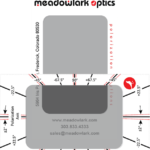Spatial Light Modulator Principles
Download Principles Meadowlark Optics award-winning Spatial Light Modulators (SLMs) provide precision retardance control for spatially varying phase or amplitude requirements. Our SLMs consist of liquid crystal (LC) pixels, each independently addressed, acting as separate variable retarders. These SLMs are easily incorporated into optical systems requiring programmable masks and variable input/output devices. Applications include correlation, spectroscopy, […]
Spatial Light Modulator Principles Read More »


